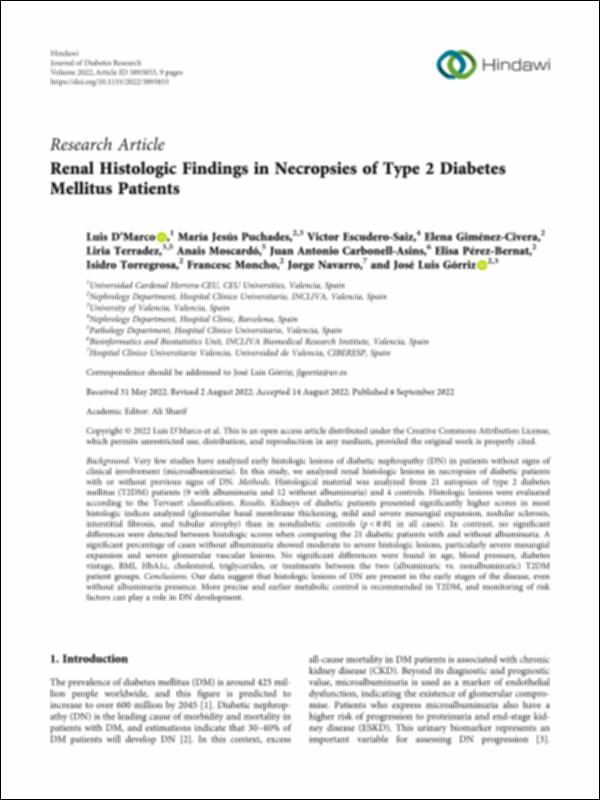Please use this identifier to cite or link to this item:
http://hdl.handle.net/10637/14388Renal histologic findings in necropsies of Type 2 Diabetes Mellitus patients
| Title: | Renal histologic findings in necropsies of Type 2 Diabetes Mellitus patients |
| Authors : | D'Marco Gascón, Luis Gerardo Puchades Montesa, María Jesús Escudero Saiz, Víctor Giménez Civera, Elena Terrádez Mas, Liria Moscardó Navarro, Anais |
| Keywords: | Diabetic nephropaties.; Diabetes - Complications.; Diabetes - Complicaciones y secuelas.; Albuminuria.; Nefropatías diabéticas. |
| Publisher: | Hindawi |
| Citation: | D'Marco, L., Puchades, M. J., Escudero-Saiz, V., Giménez-Civera, E., Terradez, L., Moscardó, A., Carbonell-Asins, J. A., Pérez-Bernat, E., Torregrosa, I., Moncho, F., Navarro, J. & Górriz, J. L. (2022). Renal histologic findings in necropsies of Type 2 Diabetes Mellitus patients. Journal of Diabetes Research, vol. 2022, art. 3893853 (06 sep.). DOI: https://doi.org/10.1155/2022/3893853 |
| Abstract: | Background. Very few studies have analyzed early histologic lesions of diabetic nephropathy (DN) in patients without signs of clinical involvement (microalbuminuria). In this study, we analyzed renal histologic lesions in necropsies of diabetic patients with or without previous signs of DN. Methods. Histological material was analyzed from 21 autopsies of type 2 diabetes mellitus (T2DM) patients (9 with albuminuria and 12 without albuminuria) and 4 controls. Histologic lesions were evaluated according to the Tervaert classification. Results. Kidneys of diabetic patients presented significantly higher scores in most histologic indices analyzed (glomerular basal membrane thickening, mild and severe mesangial expansion, nodular sclerosis, interstitial fibrosis, and tubular atrophy) than in nondiabetic controls (p < 0:01 in all cases). In contrast, no significant differences were detected between histologic scores when comparing the 21 diabetic patients with and without albuminuria. A significant percentage of cases without albuminuria showed moderate to severe histologic lesions, particularly severe mesangial expansion and severe glomerular vascular lesions. No significant differences were found in age, blood pressure, diabetes vintage, BMI, HbA1c, cholesterol, triglycerides, or treatments between the two (albuminuric vs. nonalbuminuric) T2DM patient groups. Conclusions. Our data suggest that histologic lesions of DN are present in the early stages of the disease, even without albuminuria presence. More precise and earlier metabolic control is recommended in T2DM, and monitoring of risk factors can play a role in DN development. |
| Description: | Este artículo se encuentra disponible en la siguiente URL: https://downloads.hindawi.com/journals/jdr/2022/3893853.pdf Este artículo de investigación pertenece al número especial "Novel Therapeutics Agents to Slow the Progression of Diabetic Kidney Disease". En este artículo de investigación también participan: Juan Antonio Carbonell-Asins, Elisa Pérez-Bernat, Isidro Torregrosa, Francesc Moncho, Jorge Navarro y José Luis Górriz. |
| URI: | http://hdl.handle.net/10637/14388 |
| Rights : | http://creativecommons.org/licenses/by/4.0/deed.es |
| ISSN: | 2314-6745 2314-6753 (Electrónico) |
| Language: | es |
| Issue Date: | 6-Sep-2022 |
| Center : | Universidad Cardenal Herrera-CEU |
| Appears in Collections: | Dpto. Medicina y Cirugía |
Items in DSpace are protected by copyright, with all rights reserved, unless otherwise indicated.


